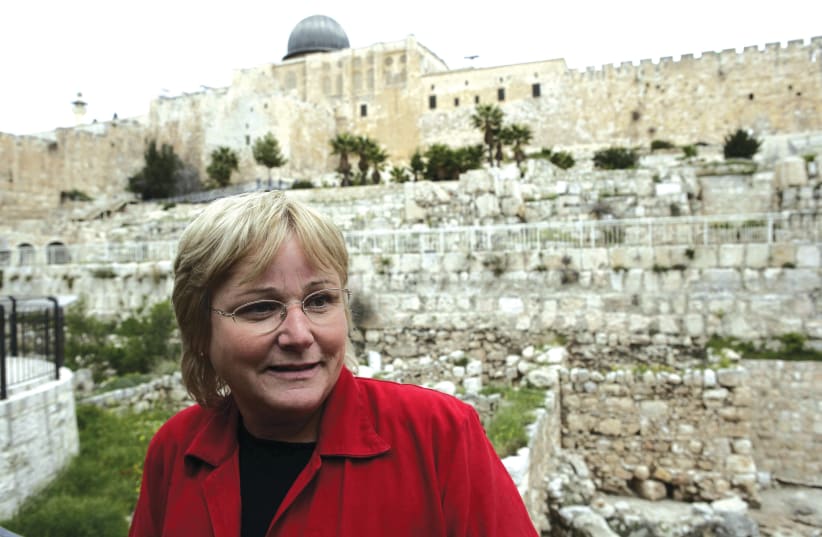The excitement in her voice as she shared with me, as Jerusalem correspondent, a new find radiated over the phone, day or night. Both as an archaeologist and a human being, she was deeply passionate and compassionate. A lover of history and archaeology and an ardent patriot, her face would shine with light and her eyes sparkle as she detailed centuries past, and did the work to connect the dots that is archaeology.
Strong like the bedrock she sifted through, she pushed ahead undeterred by her critiques, and buoyed by her spirit. She and history were intertwined as one.
Mazar’s sensational find of the palace of King David in the ancient City of David just outside the walled Old City lit up the archaeological world in fierce scholarly debate over the interpretations proffered by the unabashed biblical archaeologist who, much to the chagrin of her detractors, never put down her heavily bookmarked Bible.
“I work with the Bible in one hand and the tools of excavation in the other,” Mazar said. “The Bible is the most important historical source and therefore deserves special attention.”
Her landmark excavations in the ancient City of David were followed by a subsequent treasure trove of archaeological discoveries, including sections of King Solomon’s walls, and clay seals belonging to King Hezekiah and possibly Isaiah the Prophet, a gold treasure trove from the Persian conquest 1,400 years ago, including 50 gold coins and a large gold medallion bearing the symbol of the menorah from the Temple, and a variety of other archaeological gems.
Mazar was ever so passionate about her work, hailing from both a time and family lineage where archaeology was so closely intertwined with the building of the state.
Even the seemingly smallest find – like a seal impression or bulla – would fill her eyes with brightness, as she embarked on a passionate explanation of its importance.
It often appeared that she was more at home in the outdoor tents of the excavation under the scorching sun than in her air-conditioned Jerusalem office. In both settings, the Book of Books always accompanied her.
THE SCION of a venerated family of archaeologists, Mazar took part in her first dig at the age of 11, helping out at the excavation of her grandfather, Prof. Benjamin Mazar, who headed the excavations around the Western Wall following the reunification of Jerusalem in the 1967 Six Day Way.
Three-and-a-half decades later, it would be the younger Mazar who, as a pioneering archaeologist of her own merit and widowed mother of four, would make what is likely the most stunning archaeological discovery in Israel in decades: the famed palace of King David.
Although her watershed find was contested at the time and the scholarly debate continues, the Hebrew University, in announcing her death, now presents her discovery as matter of fact.
“During her tenure, Mazar unearthed King David’s Palace in City of David,” the university tweeted.
A staunchly secular Zionist who, like her contemporaries of an earlier time, knew verses of the Bible by heart, Mazar was both revered by Christian Zionists for her use of the Bible as a blueprint, while assailed – if increasingly respected – by her predominantly liberal colleagues in academia.
No stranger to speaking her mind, Mazar had previously spearheaded a small group of Israeli archaeologists and public figures who lambasted the Wakf Islamic religious trust, which administers the Temple Mount, for its destruction of antiquities in its expansion of an underground mosque at the site.
At the time, she became the leading Israeli archaeologist to publicly condemn the Wakf’s carting off of thousands of tons of earth from the Mount without archaeological supervision, nearly single-handedly bringing the issue to the public fore.
Her vocal criticism included her own bosses at the state-run Antiquities Authority, which, along with the Jerusalem police, largely turned a blind eye to the goings-on at the bitterly contested holy site at a time of when Palestinian violence was flaring in Israel.
Warned by colleagues that her continued public fight for justice over the years would cost her both personally and professionally, Mazar refused to give up, becoming something of a black sheep in the archaeological community years before her historic finds that brought her to international prominence.
In the years that followed her subsequent discoveries, she would go on to publish over 10 books on the archaeology of Jerusalem, documenting her finds and catapulting her to the title of the greatest Jerusalem scholar of the generation.
Indeed, the indomitable and immeasurably modest Mazar never flinched as she rose to national and international fame as the doyenne of ancient Jerusalem, saying that people would eventually see her truths, even if it took them some time to come around. And, increasingly, as the years went by, she has been proven right.
“It’s nice to touch your history,” she told me, shortly after her most prominent discovery.
Mazar’s untimely death Tuesday cut short her rich life walking through and highlighting history, but her legacy, like the golden limestones of Jerusalem she so cherished, will unequivocally live on.
The writer was a former Jerusalem correspondent at The Jerusalem Post.
